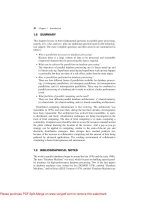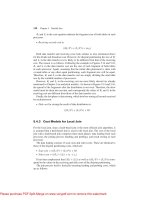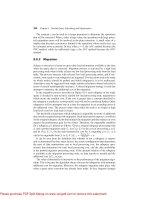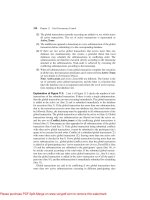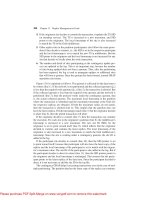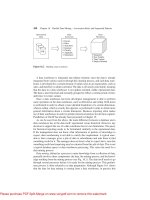Database 3: Improving Database Processing pot
Bạn đang xem bản rút gọn của tài liệu. Xem và tải ngay bản đầy đủ của tài liệu tại đây (988.83 KB, 31 trang )
1
our practice makes you perfect
SM
www.systemanage.com
Database 3:
Improving Database
Processing
Charlie Arehart
Founder/CTO Systemanage
SysteManage: our practice makes you perfect
SM
our practice makes you perfect
SM
www.systemanage.com
Agenda
Ø Eight Measures of Architectural Quality
Ø DB Performance and Scalability:
– Query Caching
– BlockFactor
– Indexes
Ø DB Reliability:
– Constraints
– Triggers
– Transaction Management
– Bind Parameters
Ø DB Extensibility and Maintainability:
– Stored Procedures
Ø The Other Measures of Quality
Ø Where to Learn More and Q&A
2
our practice makes you perfect
SM
www.systemanage.com
Part 3 of 3
Ø This seminar is part 3 of 3 presented today
– Previous two were in conference “beginner” track
Ø Part 3 is in “Advanced” track
– Won’t lose those who’ve made it this far
– May discuss things that advanced developers have
already heard (more than once)
• May hear it in a different way today
• Or leave thinking about it differently than before
• May simply trigger your putting them into effect
Ø More than just “how to”
– Focus as much on why, architectural perspective
– 50% is CF-specific, rest meaningful to other
developers
our practice makes you perfect
SM
www.systemanage.com
Database Server
Databases & Overall
Architecture
Ø Database processing is just part of your overall
system and information architecture including:
– Web server, CF server, DB server
– As well as DB design, SQL code, CF code
Ø Should evaluate entire system in terms of quality
Personnel
Orders
Products
CF Server
Web Server
3
our practice makes you perfect
SM
www.systemanage.com
Eight Measures of Architectural
Quality
Ø Sun Microsystems defines eight measures of
architectural quality
– Offered in regard to Java Enterprise (J2EE) platform
– Apply just as well to considering CF/DB architecture
– Create a backdrop considering various techniques
to improving database processing
ManageabilityExtensibility
SecurityReliability
AvailabilityScalability
MaintainabilityPerformance
our practice makes you perfect
SM
www.systemanage.com
Performance & Scalability
Ø Performance:
– A measure of the effectiveness of your application
(and database design and server platform), in terms
of response time, transaction throughput, and/or
resource usage
– Always involves tradeoffs of cost/benefit
Ø Scalability:
– Ability to support the required quality of service as
load (number of users, volume of data) increases
– Today’s small application (or your tests) may not
reflect future
4
our practice makes you perfect
SM
www.systemanage.com
Reliability, Extensibility &
Maintainability
Ø Reliability:
– Assurance of the integrity and consistency of the application
and all its transactions
– May suffer with increased load
• But ensuring reliability may negatively effect scalability
Ø Extensibility
– Ability to add/modify additional functionality without impacting
existing functionality
– Given the high effort involved in maintenance, this is more
important than many recognize
Ø Maintainability
– Ability to correct flaws in the existing functionality without
impacting other components/systems
– Includes modularity, documentation
our practice makes you perfect
SM
www.systemanage.com
Other Measures of Architecture
Ø Not really the focus of topics in this seminar
– Some tips at conclusion
Ø Availability
– Assurance that a component/resource is always available
– Can be enabled with redundancy and failover
Ø Security
– Ability to ensure that the system has not been compromised
– By far the most difficult to address
– Involves protecting confidentiality, integrity, availability, more
Ø Manageability
– Ability to manage the system in order to ensure continued
health with respect to previous measures
– Involves both monitoring and ability to improve systemic
qualities dynamically without changing system
5
our practice makes you perfect
SM
www.systemanage.com
Addressing the Challenges
Ø One approach to scalability/performance concerns:
– Add more memory/processors
• Tends to have good impact on all parts of system with
little negative
Database Server
Personnel
Orders
Products
CF Server
Web Server
our practice makes you perfect
SM
www.systemanage.com
Addressing the Challenges
Ø One approach to scalability/performance concerns:
– Add more memory/processors
• Tends to have good impact on all parts of system with
little negative
Personnel
Orders
ColdFusion
Server
ColdFusion
Server
Web Server
ColdFusion
Server
Web Server
Personnel
Orders
Database Server
Personnel
Orders
Products
6
our practice makes you perfect
SM
www.systemanage.com
Clusters and Distributed
Servers
Ø Another solution:
– Distribute processing across multiple servers
• May be simply segregating CF Server and DB server
– Again, generally a very good idea
• May involve creating cluster for web server
– Tends to add complexity to design and
implementation
Personnel
Orders
ColdFusion
Server
ColdFusion
Server
Web Server
ColdFusion
Server
Web Server
Personnel
Orders
Database Server
Personnel
Orders
Products
our practice makes you perfect
SM
www.systemanage.com
Clusters and Distributed
Servers
Ø Another solution:
– Distribute processing across multiple servers
• May be simply segregating CF Server and DB server
– Again, generally a very good idea
• May involve creating cluster for web server
– Tends to add complexity to design and
implementation
Personnel
Orders
ColdFusion
Server
Web Server
ColdFusion
Server
Web Server
ColdFusion
Server
Web Server
Personnel
Orders
Database Server
Personnel
Orders
Products
7
our practice makes you perfect
SM
www.systemanage.com
Improving Design &
Implementation
Ø May be able to improve performance/scalability
without new hardware
– Features in DB design, SQL, and CF can help
– Many are useful even in relatively small applications
• Should design for performance, keeping in mind
cost/benefit tradeoffs
Ø Design/implementation choices impact other facets
– Reliability, extensibility, maintainability, security
Ø Some features revolve around design of database
– Most simply involve more effective use of db
our practice makes you perfect
SM
www.systemanage.com
DB Processing: Key for CF App
Ø DB processing is single biggest bottleneck in most CF apps
– Sadly, many will blame CF itself
– Usually, the problems are preventable
Ø Typical things that can degrade quality of DB processing:
– Poor database and table design
– Use of non-relational tables
– Use of incorrect data types
– Poorly written SQL
– Lack of indexes
– Not using stored procedures, triggers
– Repeatedly requesting the same data
– And much more
Ø Previous talks have addressed some of these
– Today we’ll cover some of the rest, and more
8
our practice makes you perfect
SM
www.systemanage.com
DB Performance and Scalability
Solutions
Ø Some DB performance and scalability solutions:
– Query Caching
– BlockFactor
– Indexes
our practice makes you perfect
SM
www.systemanage.com
Repeatedly Requesting the
Same Data
Ø Many web apps suffer from unnecessarily
requesting the same data over and over
– Doesn’t really matter if DB is well-designed
Ø Examples include:
– Providing drop-down list of states on a reg. form
• When did we last add a new state?
– A company phone directory
• How often are employees added/removed?
– Reporting management information
• Does it need to be accurate to the second?
– Showing search results n-records at a time
• Search criteria doesn’t change for “next 10” records
9
our practice makes you perfect
SM
www.systemanage.com
Query Caching
Ø CF provides two means of caching query results for re-use
– Variable-based query caching
• Leverages ability to store any variable in server, application, or
session scope
• Since a query resultset is a variable, it can be scoped as such
• May surprise those who never thought of it
– Time-triggered query caching (a.k.a. “query result caching”)
• New attributes for CFQUERY to indicate that any code executing
that query should create/use cached copy for given timeframe
– Will show how to use each of these
Ø Also look into CFCACHE and CFSAVECONTENT tags
– These cache the entire CF page or page portions
– Not covered in this seminar but important to performance
our practice makes you perfect
SM
www.systemanage.com
Variable-based Query Caching
Ø ColdFusion offers 3 scopes for storing persistent
variables:
– Session scope
• Persists for the life of a single user’s session until
server is restarted or session times out
– Application scope
• Persists for all users of a given application until server
is restarted
– Server scope
• Persists for all users of entire CF server until server is
restarted
Ø I’ll have to presume for this class that you
understand setup and use of these
10
our practice makes you perfect
SM
www.systemanage.com
Variable-based Query Caching
Ø Just as we can assign variables to these scopes
– we can declare that a CFQUERY NAME value use a
persistent scope, as in:
– Now, this query result set is stored with all other application
variables
• Can be referred to by any code anywhere in this application
– meaning, under control of same CFAPPLICATION
<CFQUERY DATASOURCE=“ProdPrsnl” NAME=“application.GetStates”>
SELECT State, StateAbbrev
FROM States
</CFQUERY>
<SELECT NAME=“state”>
<CFOUTPUT QUERY=“application.GetStates”>
<OPTION VALUE=“#StateAbbrev#”>#State#
</CFOUTPUT>
</SELECT>
our practice makes you perfect
SM
www.systemanage.com
Avoid Recreating Cached
Resultset
Ø Once cached, query shouldn’t be executed again
– At least not until the data it reflects changes
Ø How to avoid executing query if already “cached”?
– Test if query already exists, with IsDefined()
Ø Now this query will be executed only once but be
available for the life of its indicated scope
<CFIF NOT IsDefined(“application.GetStates”)>
<CFQUERY DATASOURCE=“ProdPrsnl” NAME=“application.GetStates”>
SELECT State, StateAbbrev
FROM States
</CFQUERY>
</CFIF>
11
our practice makes you perfect
SM
www.systemanage.com
Where to Create/Update
Variable-based Cached Query?
Ø Where might it be sensible to put query creation
code to be cached for all app users?
– Application.cfm
Ø When should the query be re-executed?
– Whenever its underlying database table changes
• In whatever template performs changes to data
• Only dilemma: if code outside your control updates
DB
Ø Consider use of session scope to hold a user’s
search results over many “next n” pages?
– Create/cache it on the search action page
our practice makes you perfect
SM
www.systemanage.com
Another Challenge: Locking
Issues
Ø Shared scope variables should be locked when written to
– Should probably instead code query as:
– Note use of “exclusive” type of lock
• Not wrapping query in lock because you should avoid holding
locks any longer than needed
– Why make lock wait for query to run?
– It should just be locked for however long it takes to assign
the result set to the persistent variable
<CFQUERY DATASOURCE=“ProdPrsnl” NAME=“GetStates”>
SELECT State, StateAbbrev
FROM States
</CFQUERY>
<CFLOCK SCOPE="APPLICATION" TYPE="EXCLUSIVE" TIMEOUT="5">
<CFSET application.GetStates= GetStates>
</CFLOCK>
12
our practice makes you perfect
SM
www.systemanage.com
Locking Issues (cont.)
Ø Should also lock when reading
– Could code CFOUTPUT loop as:
– Note use of “readonly” type of lock
– Note too that TIMEOUT attribute in each case has nothing to
do with how long this lock will take
• It’s how long this lock will wait for lock being held by others
– Could instead assign cached result to local variable within
lock (locking just that assignment) and loop over that
• Will likely release lock faster (for benefit of others updating
same-scoped variables)
• Comes at cost of creating local copy of resultset each time
<CFLOCK SCOPE="APPLICATION" TYPE=“READONLY" TIMEOUT="5">
<SELECT NAME=“state”>
<CFOUTPUT QUERY=“application.GetStates”>
<OPTION VALUE=“#StateAbbrev#”>#State#
</CFOUTPUT>
</SELECT>
</CFLOCK>
our practice makes you perfect
SM
www.systemanage.com
More Challenges
Ø More challenges of variable-based cached queries
– You’re responsible for managing cache (creating,
updating)
• To delete cache, delete variable
– <CFSET x = StructDelete(application,”GetEmployees”)>
– Be careful about creating too many
• They’re just stored in memory
– Large queries could take a lot of memory
• No way for admin to limit memory used
13
our practice makes you perfect
SM
www.systemanage.com
More Challenges
Ø More challenges of variable-based cached queries
– You’re relying on previous code to have created the cache,
such as application.cfm in one example
• Can look confusing to developers unfamiliar with this form of
caching
• And what if it didn’t exist? Hadn’t been run?
– Consider how CFPARAM creates a variable only if it doesn’t
exist
• Wouldn’t it be nice if you could just do the query where you need
it?
– and if it hadn’t been cached, it would be?
– And, further, it would automatically re-cache itself at defined
intervals (after x minutes, or after certain date)
Ø Next alternative to query caching solves these problems
our practice makes you perfect
SM
www.systemanage.com
Time-triggered Query Caching:
CACHEDAFTER
Ø Referred to in “Certified CF Developer Study Guide” as
“Query Result Caching”
Ø Does not involve creating variables
– Instead, specify a caching attribute on CFQUERY
• CACHEDAFTER or CACHEDWITHIN
– Example:
– This would cache the result the first time the query is run after
specified date/time (and use the cache from then on)
• Meant to be used with fixed date/time, in the future
• Might be useful when you know data is updated at 10pm
<CFQUERY DATASOURCE=“ProdPrsnl” NAME=“GetSales”
CACHEDAFTER=“09-01-01 10:00 pm”>
SELECT * FROM
FROM SalesStats
</CFQUERY>
14
our practice makes you perfect
SM
www.systemanage.com
Time-triggered Query Caching:
CACHEDWITHIN
Ø CACHEDWITHIN works differently
– This would cache the result the first time the query is run and
reuse the cache each time query is executed
• until specified timespan has passed since it was first cached
• will re-cache it the next time it’s run after specified timespan
• Meant to be used with relative time span
– Can be specified in either days, hours, mins, secs
• Useful to cache for a specific amount of time from the first time
it’s cached
– CFML reference mistakenly indicates this should “define a
period of time from the present backwards”
<CFQUERY DATASOURCE=“ProdPrsnl” NAME=“GetEmployees”
CACHEDWITHIN=“#CreateTimeSpan(0,0,5,0)#”>
SELECT * FROM
FROM Employees
</CFQUERY>
our practice makes you perfect
SM
www.systemanage.com
Time-triggered Query Caching:
Issues
Ø Can observe if query was taken from cache
– If debugging is turned on, query time shows “cached
query”
• Note that CFQUERY.ExecutionTime variable does
NOT show this value
– Shows “0”, doesn’t always mean it was a cached
query
Ø Important difference from variable-based caching
– Query remains where it normally would appear
– No need to test existence, no shared variables
used, no need to worry about <CFLOCK>
15
our practice makes you perfect
SM
www.systemanage.com
Time-triggered Query Caching:
Dynamic Queries
Ø A single CFQUERY may generate multiple cached
results
– If SQL is built dynamically, each unique SQL
statement is cached separately
• Consider search action page driven by form fields
– Same CFQUERY with different resulting SQL will
create separate cached result
– Pro
• Means more potential to benefit from cache
– Con
• Means lots of cached results could be created
our practice makes you perfect
SM
www.systemanage.com
Time-triggered Query Caching:
Admin Settings
Ø Time-triggered caching is governable by admin
settings
– Can restrict total number of cached queries allowed
– Limit the maximum number of cached queries on
the server to xxx queries
• When the limit is exceeded, oldest query is dropped
and replaced
• Defaults to 100 on installation of CF
– Can disable this sort of caching by setting to 0
16
our practice makes you perfect
SM
www.systemanage.com
Time-triggered Query Caching:
Sharing Cached Results
Ø Mentioned previously that unique SQL in same
query will result in different cached results
– Conversely, and perhaps unexpectedly to many,
cached result for given SQL can be reused by
another CFQUERY
• To reuse another query’s cached result, query must
have identical SQL and DATASOURCE
– And, if specified, identical DBTYPE and Login info
• Doesn’t need to have same query NAME
• Of course, doesn’t need to be in same template
– Nor even in same application
our practice makes you perfect
SM
www.systemanage.com
More About CachedAfter
Ø CF docs are very sparse about CACHEDAFTER
– Both the docs and the Certification Study Guide say
it supports only a date
• Will support a date and time
– Can specify date as any valid CF date, then add
time
» such as “09/01/01 10:00pm” or “09-01-2001
22:00”
• To cache each day as of 10pm, use
– CACHEDAFTER="#dateformat(now())# 22:00"
• Can’t, however, just specify a time
17
our practice makes you perfect
SM
www.systemanage.com
Another Performance Factor:
BlockFactor
Ø BLOCKFACTOR gets a lot of press by some as important
performance factor
– May not bring value for most
– Also easily misunderstood
Ø When CF and database communicate to create result set,
may transer only one record at a time
– Applies to some DB drivers
• ODBC, Oracle according to docs
– BLOCKFACTOR is an attribute on CFQUERY
• Allows specifying a number of records to transfer at a time
• Does NOT control HOW MANY records are retrieved
– If not supported by DB driver, won’t cause error
• but could degrade performance
– If supported but set too large, could degrade performance
– Many feel it’s best to not set at all
our practice makes you perfect
SM
www.systemanage.com
About DB Column Indexes
Ø When column in table is searched, does the DBMS look at
each record in entire table, one at a time?
– Yes, if the column is not indexed
– Think of index as similar to a book’s index
• Just as we can find info quickly, so can DBMS
• Can have dramatic impact on performance of queries
– In small tables, lack of index may not be noticeable
• Then again, with more users doing more queries, could become
a problem
– Whether a column is indexed is optional
• Except that primary key is always indexed
• Should consider adding index to columns frequently searched
– May also improve sorting by a given column
– Beware: indexing a column isn’t always a good idea
18
our practice makes you perfect
SM
www.systemanage.com
Indexing Cautions
Ø Before rushing off to create indexes on too many
columns, consider a few cautions:
– Each index requires time to be maintained during
record insert/udpate operations
– Not all data is suitable for indexing
• Depending on indexing technique used by DBMS,
data without many unique values may not benefit
– State may not be good index while lastname is
– Indexed data does add to storage requirement for
DB
our practice makes you perfect
SM
www.systemanage.com
Creating/Adding Indexes
Ø To add an index to a table for a given column
– Indexname must be unique within given table
– Can create index before or after populating table
with data
Ø CF and even SQL coding isn’t typically changed by
adding indexes
– Just see improved query performance (at tradeoff of
aforementioned cautions)
CREATE INDEX indexname
ON tablename (columnname)
19
our practice makes you perfect
SM
www.systemanage.com
DB Reliability Solutions
Ø Some DB reliability solutions:
– Constraints
– Triggers
– Transaction Management
– Bind Parameters
our practice makes you perfect
SM
www.systemanage.com
About DB Column Constraints
Ø In Database 2 seminar, we learned about inter-related tables
and how to create JOINs between them
– Learned that, in this example, values of Employees.DeptID
reflect those in Departments.DeptID
• Can be used to lookup Dept name by way of joining them
– What ensures that the only values stored in
Employees.DeptID come from Departments.DeptID?
• Many developers don’t take steps to ensure this
212-01-00Cindy2
106-04-98Bob1
4
3
EmpID
Employees
205-30-99Beth
101-01-01John
DeptIDHireDateName
Engineering2
Sales1
DeptDeptID
Departments
20
our practice makes you perfect
SM
www.systemanage.com
Problems Managing Related
Table Values
Ø Others take responsibility to manage it themselves
– Trying to maintain this form of integrity is
challenging
– Need to do it everywhere data may be updated
– Also need to do it for updates/deletes
– Take effort to code, then execute, such checks
Ø Far better to let DBMS manage this itself
our practice makes you perfect
SM
www.systemanage.com
Creating/Adding Constraints
Ø Can create constraints for and between such
related table columns
– With this in place, an attempt to insert invalid value
for DeptID in Employees (a value not in
Departments.DeptID column), DB will throw error
– Can catch this error in CF with CFTRY
• Surround CFQUERY doing insert/udpate
ALTER TABLE Employees
ADD CONSTRAINT FK_DeptID
FOREIGN KEY (DeptID)
REFERENCES Departments (DeptID)
21
our practice makes you perfect
SM
www.systemanage.com
About Unique Constraints
Ø Similar dilemma arises when you want unique
values for a given column
– May want to prevent multiple records with same
email address
• Learned in previous seminar that primary key values
are guaranteed to be unique
• But what if column (like email) is not the primary key?
– Again, could try to manage this yourself
• Doing test before doing insert/update to ensure email
address value doesn’t already exist
– Or could have DBMS manage it, with unique
constraint
• May be created with CREATE UNIQUE INDEX or
with another kind of CONSTRAINT
our practice makes you perfect
SM
www.systemanage.com
About Check Constraints
Ø Still another reliability option is that some
databases allow creation of Check Constraints
– These are defined for a given column to ensure
values meet some defined criteria
– Examples include:
• minimum/maximum values
• range of values
• List of possible values
22
our practice makes you perfect
SM
www.systemanage.com
Visually Defining Indexes,
Constraints
Ø SQL statements will work for nearly all DBMS’s
– Many DBMS’s offer visual interface for managing
these
• MS Access “Design Table” and “Tools>Relationships”
features
• SQL Server Enterprise Manager
• And more
– Again, be aware that in many instances, the defaults
are to not define indexes, constraints
• If you’d like to use them, you may need to add them
our practice makes you perfect
SM
www.systemanage.com
Ensuring Further Data
Reliability
Ø We know that constraints can ensure that data
meets certain criteria during insert/update
Ø May need to ensure further integrity
– May want to convert data to uppercase during
insert/update
– May need to write data to another table on
insert/update
• keeping accountbalance column in account table
updated for each deposit/withdrawal tracked in
transaction table
– May need to check data in another table before
allowing insert/update
23
our practice makes you perfect
SM
www.systemanage.com
Triggers
Ø Some DBMS’s allow creation of triggers to perform these
sort of integrity checks and cross-table update
– Specified in form of SQL statements
– Stored in database, associated with given table
– Typically can define separate triggers to act upon insert,
update, and/or delete against that table
– Syntax will differ between DBMS’s. An example:
– When performing similar actions, constraints typically execute
more quickly than triggers (use them instead)
CREATE TRIGGER triggername
ON tablename
FOR INSERT|UPDATE|DELETE
AS
UPDATE tablename SET columnname=UPPER(columnname)
WHERE tablename.columnname = INSERTED.columnname
our practice makes you perfect
SM
www.systemanage.com
Transaction Management
Ø Multiple users can (and generally do) update data
in databases at the same time
– Transaction processing prevents them updating the
exact same data at the same time
– Also allows a group of related updates to be
packaged such that if they don’t all succeed, none
will succeed
Ø Generally controlled by the DBMS for us
– We can influence it from within CF by way of the
CFTRANSACTION tag
Ø See Chapter 19 of Certification Study Guide for
more details and code samples
24
our practice makes you perfect
SM
www.systemanage.com
Grouping Updates
Ø When multiple updates must take place, otherwise
none should take place, use CFTRANSACTION
Ø This simplest and oldest form simply ensures that
if the first update fails, the second will as well
– Called backing out or “rolling back” the first update
– Up to the database to handle the rollback
• More advanced DBMS will handle rollback even after
recovering from crash of DB server that may have
caused transaction to fail in the first place
<CFTRANSACTION>
<CFQUERY >
UPDATE Checking SET Balance=Balance-100
WHERE AccountID = 1234
</CFQUERY>
<CFQUERY >
UPDATE Savings SET Balance=Balance+100
WHERE AccountID = 1234
</CFQUERY>
</CFTRANSACTION>
our practice makes you perfect
SM
www.systemanage.com
Isolation Levels
Ø When performing a group of transactions, need to be careful
about other users reading the data we update, and vice-
versa
– Databases generally define up to 4 isolation levels that can
influence these sort of cross-user locks, from
• Serializable (default)
– Can indicate that no reads/updates by others take place
during our update
• Through Repeatable_Read and Read_Committed
– Not supported by all DBMS’s
• Read_Uncommitted
– Or can indicate that we don’t care if others are
reading/updating
Ø We can specify a desired isolation level with
CFTRANSACTION ISOLATION attribute
25
our practice makes you perfect
SM
www.systemanage.com
Programmable
Commit/Rollback
Ø Mentioned that CFTRANSACTION would rollback all updates
if any failed
– Didn’t mention, but COMMIT takes place at end of transaction
• Commit tells DBMS to consider update finished
– CFQUERY updates outside CFTRANSACTION also do
COMMIT at end of CFQUERY
– Release 4.5 added ability to perform BACKOUT (and
COMMIT) programatically within transaction
• <CFTRANSACTION ACTION=“Backout|Commit”/>
– This tag is designed to be used within other
CFTRANSACTION tag
» Doesn’t allow embedded tags of its own, but needs to
be closed to avoid confusion with surrounding
CFTRANSACTION
» Could use closing </CFTRANSACTION> tag or just
closing slash at end of tag, as above
our practice makes you perfect
SM
www.systemanage.com
Ø ColdFusion is a loosely typed language
– Numbers considered string until used for math
Ø Databases are strongly typed
– Column expecting numbers will want numbers
– But CF will be passing a string that looks like number
• Database can do conversion to fix that
• But we can help the database to know the datatype
• Can help performance by specifying bind parameters
Using Bind Parameters
<CFQUERY >
SELECT * FROM EMPLOYEES
WHERE EmpID =
<CFQUERYPARAM CFSQLTYPE="CF_SQL_INTEGER" VALUE="#url.empid#">
</CFQUERY>

